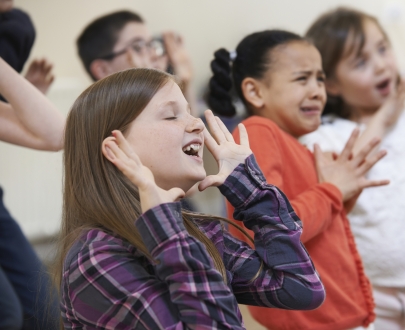 Children love performing and watching themselves on film. This lesson uses scenario planning, acting, filming and analyzing to practice solving problems peacefully in ways that are relevant and personalized for students. It can be adapted to any age level simply by adjusting the depth of dialogue and complexity of conflict situations. The process helps students develop empathy by providing them with an opportunity to think and apply their knowledge and experience to conflict and problem solving skits. Research shows that empathy is positively linked[1] to peaceful conflict resolution and both predicts successful conflict management as well as reduces the likelihood of getting involved in conflict in the first place.
Children love performing and watching themselves on film. This lesson uses scenario planning, acting, filming and analyzing to practice solving problems peacefully in ways that are relevant and personalized for students. It can be adapted to any age level simply by adjusting the depth of dialogue and complexity of conflict situations. The process helps students develop empathy by providing them with an opportunity to think and apply their knowledge and experience to conflict and problem solving skits. Research shows that empathy is positively linked[1] to peaceful conflict resolution and both predicts successful conflict management as well as reduces the likelihood of getting involved in conflict in the first place.
Learning Outcomes:
Students will be able to:
-
identify what getting along looks, sounds and feels like
-
identify peaceful choices in common school/classroom problems
-
practice working through "school or classroom conflicts" faced at school
-
reflect on the cause of the "problem" or conflict, the feelings that exist during conflict and the potential actions to solve them peacefully
Materials Required:
-
White board (brainstorm, discussion notes)
-
iPad (for filming)
-
any props or materials needed for student skits
-
projector to show or present the recorded skits
Teaching and Learning Activities:
- ACTIVATE THINKING: Write “Solving Problems Peacefully” on the board. As a class, discuss what "peace" and "peacefully"[2] means. Note that peace is not about avoiding conflict entirely or being compliant, disengaged or coerced into behaving a certain way.
- Introduce the idea of school conflict and brainstorm a list of typical problems or conflicts students face regularly. Record student responses on the board for students to reference after
- Pick one example and have student volunteers come to the front of the class and improvise the scenario for the class. Discuss WHY this conflict or problem existed. Topics that may arise include power imbalances, self-esteem, miscommunication and assumptions. Discuss the emotions that are potentially felt by those involved in the conflict scenario.
- Brainstorm what possible actions (by those involved or bystanders) might help solve this conflict or problem in peaceful ways.
- Small Group Task - explain that students will work in small groups to create and act out a typical school/classroom based conflict or problem. Suggest that each group select a problem listed from the brainstorm. In addition to the problem skit, each group will be required to discuss strategies to solving that problem scenario peacefully, choose one and act it out as a “peaceful solution.” (Prompt groups to think about what the conflict looks, sounds and feels like.)
- Film each group’s skits individually as they are ready. Each group will act out the problem and then their peaceful solution.
- Once filming is complete - watch the videos together as a class. For each small group’s video, show the problem skit first, then pause the video to hold a large group discussion on ideas to solve the scenario peacefully. Finally, show the group’s filmed version of their peaceful solution. Repeat this process for each group’s video.
- Challenge students to watch for these conflicts around the school and in the classroom to apply what they have learned.
Adaptations:
-
Prearrange the small groups to pair certain students together in terms of ability or support.
-
Students who are too shy can choose to take on a "directing role" if they don't want to be in the film.
-
Each group could have a presenter or co-hosts to discuss their video with the class.
-
Nervous students can have non-speaking roles
-
Shy groups may need encouragement and help "scripting" what to say
Follow-up Activities:
-
Have students reflect on the lesson in a journal entry
-
Older classes could share these videos with younger students through “buddy” relationships or leadership lessons
In a study of 307 teens, higher levels of empathy was found to be linked with more successful problem solving and conflict resolution.
Solving problems peacefully means using empathy, understanding other points of view and actively coming up with strategies to make things right in a fair way, while respecting others and themselves.
Three approaches to foster peaceful classrooms include:
- Create a space and emotional environment that will have universal impact.
- Explicitly teach positive communication strategies to build a repertoire of easily accessible skills.
- Engage in activities that integrate strategies and develop peaceful habits of mind.